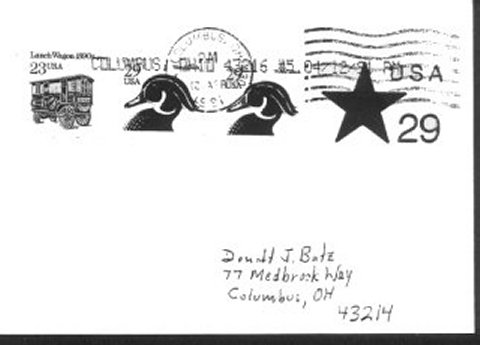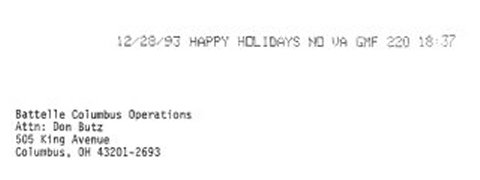
Figure 1

Figure 2

Figure 3
SPACE-TOPIC SPRAY MARKINGS ON COVER
Donald J. Butz
All of us by now, I am sure, have seen various usages of spray markings on various types of mail handled by
the U.S. Postal Service. The years 1989 and 1990 saw the first experimental usage in the U.S. on a spotty basis.
Within the next several years, numerous mail processing facilities added and tested this type of equipment. These
markings, improperly called cancellations or postmarks by some, are created by automatic, computer-driven alphanumeric
ink jet spray printers, and were initially intended for use on meter stamp mail to document actual mailing dates.
However, their early usage was seemingly just as frequent on stamped mail of all types. Spray-on markings include
brief statements, slogans or reminders, or even simple symbols, and sometimes-cryptic character strings. On an
isolated regional basis, significant numbers of holidays and local events have been commemorated or promoted as
well, with such usages typically only for short time periods. Some mail processing facilities seem to use the readily-programmable,
full printing capabilities of their equipment routinely, while for others, examples are rare. Foreign uses are
also common now, with some nations even using this capability to create the postage indicia themselves.
Not surprisingly, a subset of philatelists interested in this new form of postal marking quickly sprung up in the
U.S. and abroad. To this day, I still save all mail with spray markings that I receive! I have always been looking
for examples that have a direct tie-in to astrophilately, but have not seen any myself. In checking for these,
I have reviewed some years worth of the Meter Stamp Societyís (MSS) quarterly Meter Stamp Bulletin, and the Machine
Cancel Societyís Machine Cancel Forum, for example, as well as keeping an eye on Linnís Stamp News and Stamp Collector
periodicals.
By far the best listing of spray markings is a very comprehensive list maintained by one of the earliest and most
active collectors in this field, Mr. Wes Perkinson. The latest list I had at the time I wrote this article was
#16 (dated December 1, 1998); this had 127 pages of entries in fine print! Entries are organized by zip code (first
three digits, then local towns in alphabetical order), and cover only the U.S. His listing grew out of his many,
detailed contributions to the MSS publication and his broad contacts in the collector community, and he releases
a new update in about mid-February and mid-August of each year. He may be contacted by mail at Wes Perkinson, c/o/
Fidelity Contract Services, Inc., P.O. Box 73819, Puyallup, WA 9873-0819, and can also be reached by e-mail at
, fcs@earthlink.net.
Please enclose a S.A.S.E. when writing for information. The price of a copy of the list is about fifteen dollars
for the two semi-annual additions.
He lists the only space-related usage that I am aware of: (zipcode 711) Shreveport, LA, "SPACE ART, MEADOWS
MUSEUM SHV OCR#1 02/05/95 HH:MM" (Figure 1); Mr Perkinson catalogs this as S-1-035. I am trying to obtain
a copy on cover. The only others which are remotely close are for an airshow: (zipcode 454) Dayton, OH "20TH
ANNIVERSARY AIR SHOW DAYTON, OH 454 PM 09/23/94 OCR#13", cataloged as S-13-06, and "20 TH ANNIVERSARY
AIR SHOW DAYTON OH 454 07/21/94 OCR#14", which is S-14-03 in the catalog. The Dayton air show is always held
around July 20, and sometimes has space-related displays. Note that the former usage was dated about two months
after the air show, while the latter was during the same show.
While reviewing the above publications, particularly the latter (which has proven to be extraordinarily comprehensive)
I kept in mind names such as Kennedy Space Center, Goddard Space Flight Center, White Sands Missile Range, etc.
as representative of truly relevant space-related content. In addition, I looked for any statements that have space-related
tie-ins, such as launch and landing anniversaries, museum openings, and other local events. Certainly the preponderance
of conventional pictorial cancels indicate the frequency of space-related events commemorated in the U.S. Unfortunately,
I have still not been able to locate any evidence of other space-topic spray cancels. Perhaps this is because most
spray machines are located at large, regional mail distribution facilities. Can any readers,
U.S. or abroad, provide examples or additional insight? If you have copies, please share them with me
for a future article in the Astrophile. Those living near space-development and flight-test centers might also
consider upcoming space events, then try to get a local mail distribution center to include the event in a spray
cancel. While I do not know how to go about this, it is obvious from the many examples in Perkinsonís listing that
some mail centers routinely promote local events, some quite often. In the absence of any space topic examples,
I included the following two illustrations of spray markings. The somewhat cluttered 4/12/91 cover is an unofficial
First Day Cover (FDC) that I made here in Columbus for the 29 cent duck stamp issue (suggesting another FDC sub-specialty)
(Figure 2). The second is simply a typical, clear example from Dec. 1993 of a slogan-type spray marking
on a cover (Figure 3).
P.S. The MSS publication still covers the subject, and can be reached at Meter Stamp Society, Douglas Kelsey, Secretary/Treasurer, P.O. Box 65930, Tucson, AZ 85728-5930 (annual dues are $20.00).

Figure 1

Figure 2

Figure 3